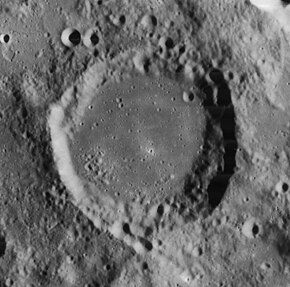Copernicus is a lunar impact crater located in eastern Oceanus Procellarum. It was named after the astronomer Nicolaus Copernicus. It typifies craters that formed during the Copernican period in that it has a prominent ray system. It may have been created by debris from the breakup of the parent body of asteroid 495 Eulalia 800 million years ago.

Arzachel is a relatively young lunar impact crater located in the highlands in the south-central part of the visible Moon, close to the zero meridian. It lies to the south of the crater Alphonsus, and together with Ptolemaeus further north the three form a prominent line of craters to the east of Mare Nubium. The smaller Alpetragius lies to the northwest, and Thebit is to the southwest along the edge of the mare.

Fra Mauro is the worn remnant of a walled lunar plain. It is part of the surrounding Fra Mauro formation, being located to the northeast of Mare Cognitum and southeast of Mare Insularum. Attached to the southern rim are the co-joined craters Bonpland and Parry, which intrude into the formation forming inward-bulging walls. The crater is named after Italian geographer Fra Mauro.

Albategnius is an ancient lunar impact crater located in the central highlands. It is named after the Mesopotamian Muslim astronomer and scientist Abū ʿAbd Allāh Muḥammad ibn Jābir ibn Sinān al-Raqqī al-Ḥarrānī aṣ-Ṣābiʾ al-Battānī, Latinized as Albategnius.
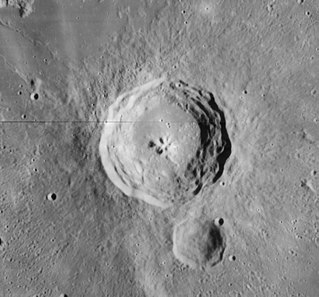
Bullialdus is a lunar impact crater located in the western part of the Mare Nubium. It was named after French astronomer Ismaël Boulliau. To the north by north-west is the broken-rimmed and lava-flooded crater Lubiniezky. South-west of Bullialdus lies the smaller crater König.

Plinius is a prominent lunar impact crater on the border between Mare Serenitatis to the north and Mare Tranquilitatis to the south. Its diameter is 41 km. The crater is named after the Roman natural scientist and author Pliny the Elder. To the south-southeast of Plinius is the crater Ross, and to the northeast is Dawes. Just to the north is a system of rilles named the Rimae Plinius and touching it is the Brackett crater which is more than a crater diameter north. At the northwest edge of the rille is the Promontorium Archerusia, a cape off the western rim that encloses the Mare Serenitatis.

Hyginus is a lunar caldera located at the east end of the Sinus Medii. It was named after ancient Roman astronomer Gaius Julius Hyginus. Its rim is split by a 220 kilometer-long rille, Rima Hyginus, that branches to the northwest and to the east-southeast. The crater is deeper than the rille, and lies at intersection of the rille's branches. Together, the crater and the rille form a prominent feature in an otherwise flat surface. Smaller craters along the length of the rille may have been caused by the collapse of an underlying structure.

Clavius is one of the largest crater formations on the Moon and the second largest crater on the visible near side. It is located in the rugged southern highlands of the Moon, to the south of the prominent ray crater Tycho. It is named for the Jesuit priest Christopher Clavius.

Horrocks is a lunar impact crater located entirely within the eroded northeast rim of the much larger walled plain Hipparchus. Its diameter is 30 kilometres (19 mi). It was named after the 17th-century English astronomer Jeremiah Horrocks. To the south of Horrocks are the craters Halley and Hind, Rhaeticus is to the north, and Pickering to the northeast. Gyldén and Saunder lie to the west and east, respectively.

Tacitus is a lunar impact crater located to the northwest of the crater Catharina, at the northern extension of the Rupes Altai ridge line. It was named after the 1st century Roman historian and writer Tacitus. Directly west is the crater Almanon, and to the northeast is Cyrillus. To the southeast of Tacitus is a long chain of craters named the Catena Abulfeda. This chain runs to the northwest from the eastern edge of the Rupes Altai, continuing for over 200 kilometers.
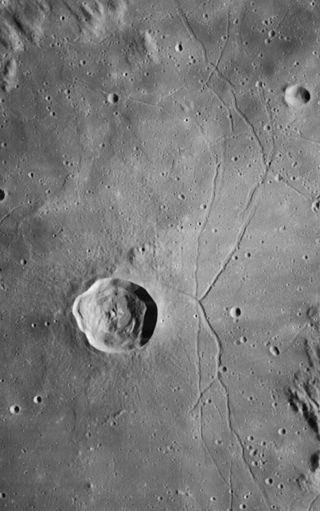
Triesnecker is a prominent lunar impact crater that is located in the Sinus Medii, near the central part of the Moon's near side. Its diameter is 25 km. It was named after Austrian astronomer Franz de Paula Triesnecker. It is located to the north-northwest of the crater Rhaeticus, and to the east-southeast of the flooded Murchison.
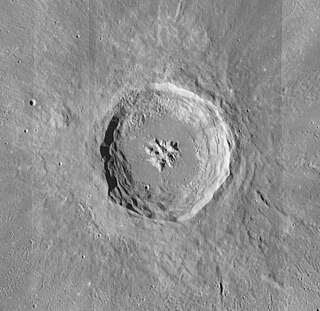
Aristillus is a prominent lunar impact crater that lies in the eastern Mare Imbrium. It was named after Greek astronomer Aristyllus. Directly to the south is the smaller crater Autolycus, while to the southwest is the large Archimedes. To the northeast are the craters Theaetetus and Cassini.

Descartes is a heavily worn lunar impact crater that is located in the rugged south-central highlands of the Moon. To the southwest is the crater Abulfeda. It is named after the French philosopher, mathematician and physicist René Descartes.

Littrow is a lunar impact crater that is located in the northeastern part of the Moon's near side, on the east edge of Mare Serenitatis. Its diameter is 29 km. The crater is named after Bohemian astronomer Joseph Johann von Littrow (1781–1840). Some distance to the northeast is the prominent crater Römer, while to the south is Vitruvius.

Agrippa is a lunar impact crater that is located at the southeast edge of the Mare Vaporum. It is located to the north of the crater Godin, the irregular Tempel lies just to the east. To the north and northeast, the rille designated Rima Ariadaeus follows a course to the east-southeast, reaching the western edge of Mare Tranquillitatis. It is named after the 1st century Greek astronomer Agrippa.
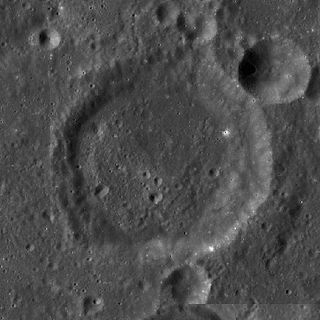
Almanon is a lunar impact crater that lies in the rugged highlands in the south-central region of the Moon. It was named after Abbasid Caliph and astronomer Al-Ma'mun. It is located to the south-southeast of Abulfeda, and to the north-northeast of the smaller crater Geber. The crater chain designated Catena Abulfeda forms a line between the south rim of Abulfeda and the north rim of Almanon, continuing for a length of about 210 kilometers to the Rupes Altai scarp.

Anděl is a lunar impact crater that lies in the rugged central highlands of the Moon. It was named after the Czech astronomer Karel Anděl. Nearby craters of note include Abulfeda to the south-southeast and Descartes to the east-southeast. About 85 kilometres to the east-northeast of the outer rim is the landing site of the Apollo 16 mission.

Davy is a small lunar impact crater that is located on the eastern edge of the Mare Nubium. It was named after British physicist Humphry Davy. It overlies the lava-flooded remains of the satellite crater Davy Y to the east, a formation which contains a crater chain designated Catena Davy. To the southeast of Davy is the prominent crater Alphonsus.

Mendeleev is a large lunar impact crater that is located on the far side of the Moon, as seen from the Earth. The southern rim of this walled plain just crosses the lunar equator. Intruding into the eastern rim of Mendeleev is the crater Schuster. Nearly on the opposite side, the smaller Hartmann intrudes into west-southwestern rim.

Necho is a lunar impact crater on the far side of the Moon, and therefore cannot be seen directly from the Earth. It lies to the northeast of the larger crater Langemak, about a crater diameter to the south-southwest of Bečvář and further east is Love.
